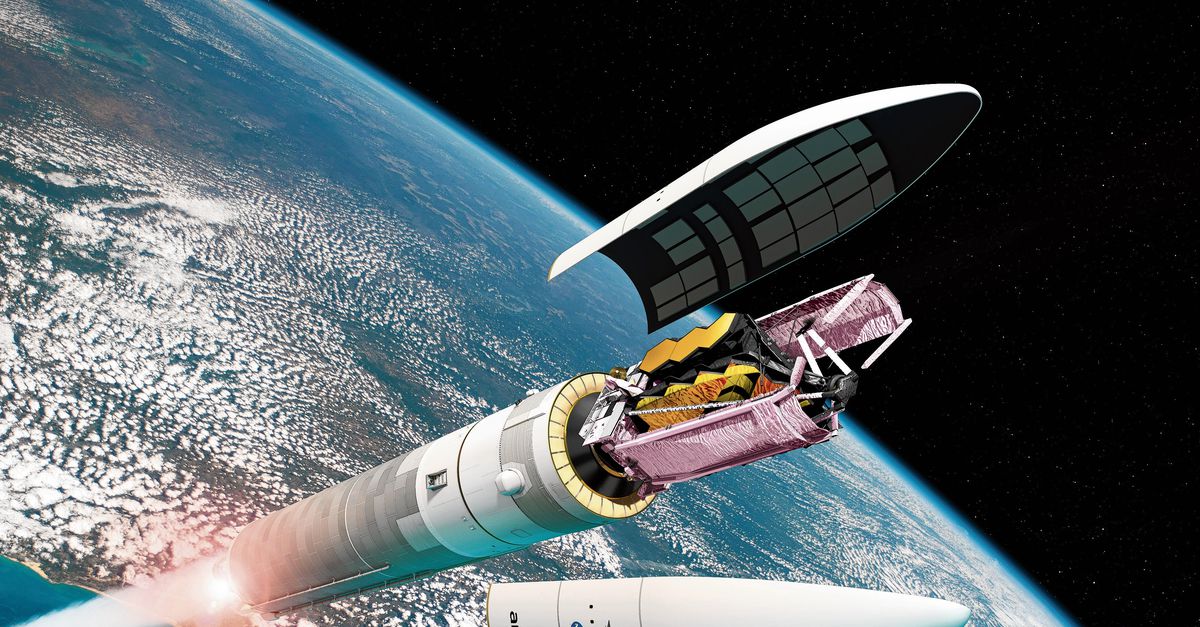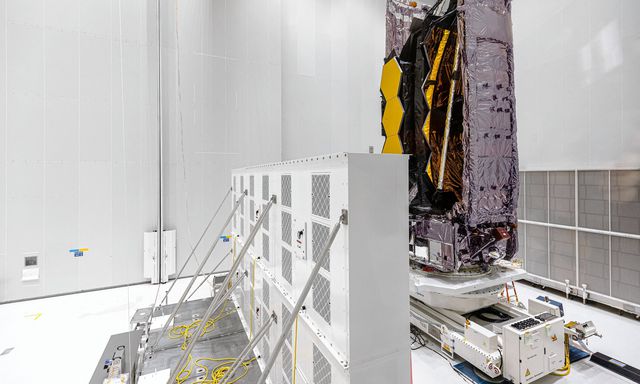finally. After a long series of delays, the James Webb Space Telescope (JWST) will leave Earth next weekend. With a 6.5-meter gold-plated mirror, made up of eighteen hexagons, the space telescope looks like a gigantic origami work of art. A work of art that took about thirty years to build and at a cost of nearly ten billion euros. The largest and most powerful space telescope ever built, JWST is the result of a collaboration between NASA, the European Space Agency (ESA) and the Canadian Space Agency (CSA). The telescope is expected to last about five to ten years.
“The launch marks a new era in astronomy,” says Ewen van Dyschewek, an astronomer at Leiden University who co-developed the James Webb Space Telescope for thirty years. “With this telescope, we will see for the first time the formation of the first stars and galaxies, right after the beginning of time.”
Infrared rays are difficult to perceive
Henk Hoekstra Professor of astronomy
Thirteen billion years old. This is when the JWST should start monitoring. The universe originated about 13.7 billion years ago with the Big Bang. Soon, there were no stars, just gas and dark matter. Later, from this gas, the first stars and galaxies appeared. Among other things, the JWST was built to consider that period. The telescope succeeds the famous Hubble Space Telescope, which continues to operate beyond all expectations. The two complement each other: telescopes orbit in different circles and look in a different light. Hubble mainly looks at visible and ultraviolet light. With four infrared instruments on board, JWST will capture the faint light from the emerging universe.
Astronomers have never looked so far back in time before, because ancient starlight is now completely stretched out by the expansion of the universe. Light needs time to travel. The deeper we look at the universe around us, the more we look back in time. The light waves from the old stars are stretched once they reach Earth. The light is emitted at a certain frequency: the light pulses with a pause in between. Due to the expansion of the universe, the pauses increase and the distances between light pulses increase. Ultraviolet light from distant stars, which has a high frequency (short periods), extends into infrared radiation when it reaches Earth. This is the kind of light we feel as heat. “It’s very difficult to monitor infrared radiation,” Henk Hoekstra says. He is a professor of astronomy at Leiden University. “It is very faint and barely distinguishable from infrared light emitted by other objects such as Earth.” It’s like looking for a needle in a haystack. Moreover, infrared light from space does not reach the Earth: it is blocked by the Earth’s atmosphere.
:format(jpeg):fill(f8f8f8,true)/s3/static.nrc.nl/images/gn4/data79853310-88d302.png)
This is the reason JWST goes to space, far from Earth and the Sun. The Japanese planet Earth will orbit the Sun, one and a half million kilometers from Earth orbiting the Sun. This is not an arbitrary distance. There, the telescope is attracted enough by the gravitational force of the Sun and Earth to stay in line with the Earth. This is called the L2 Lagrange point. It is convenient to communicate with the telescope. JWST will send the data back to Earth using an onboard radio transmitter. By the way, JWST is not the first in this orbit. For example, the Herschel Space Telescope ran there from 2009 to 2013. But it looked in a different light than that of JWST.
Sun protection factor ten million
A large sail on the surface of the tennis court (more than 21 by 24 metres) must protect the telescope from the infrared light of the Sun, Earth, and Moon, and from which the telescope itself radiates. The “canopy” consists of five layers and can be compared to a sunscreen with a factor of about ten million. The telescope separates into a warm side facing the sun and a cool side behind the screen. The maximum temperature is expected to rise on the warm side to around 100°C. The temperature on the cold side, behind the eyebrow, will be about minus 237 degrees. The visibility instruments will be behind the sunblock, on the cold side.
:format(jpeg):fill(f8f8f8,true)/s3/static.nrc.nl/images/gn4/data79853306-ad4c9b.png)
Why strange cooling? In order to pick up the weak heat signals from the young universe, the monitoring instruments need to be as cool as possible. Otherwise, the heat from the telescope would be noise from heat signals from the universe. The sunscreen was one of the biggest design challenges for JWST engineers.
This is done with great precision. Really unbelievable
Vincent Ike Professor of theoretical astronomy
“Another challenge was building a massive, strong, smooth mirror that’s also light enough to take into space,” Hoekstra says. “It’s hard to get a sharp picture with a weak infrared signal.” That is why the mirror is gigantic: 6.5 meters wide. By comparison, the Hubble mirror is 2.4 meters wide. “By using a larger mirror we can collect more light and how sharp objects are photographed also depends on the size of the mirror.” JWST can get a small patch of sky pretty sharp. If a bee was on the moon, JWST could pick up their heat. Vincent Ike, Professor of Theoretical Astronomy at Leiden University: “And the JWST mirror is polished up to thirty atoms thick. You just have to look at it and it really has a scratch. It is done with tremendous precision. Really incredible.”
Atmospheres of the outer planets
:format(jpeg):fill(f8f8f8,true)/s3/static.nrc.nl/images/gn4/data79853313-c07606.png)
Fantasy about such a telescope that could see so far back in time began as early as 1989. In 2004, engineers began building the parts and Holland made an important contribution to one of the four scientific infrared instruments, the Middle Infrared Spectrometer . This will be used, for example, to examine the chemical composition of the atmospheres of exoplanets. By looking at the colors that absorb light from the atmosphere of exoplanets, scientists can tell something about the composition of the planet’s atmosphere.
The JWST build was not without struggle. The telescope was supposed to have left Earth about fourteen years ago, but due to problems, the launch was delayed more and more. For a while it was thought to be pulling the plug completely. NASA will build the telescope for $1.6 billion, well short of the eventual $10 billion. What began as an ambitious plan became a NASA baby. Until last month, JWST was facing headwinds.
Read about the controversy surrounding the JWST naming: Anti-gay smudge on new space telescope
Scientists and engineers were thrilled when NASA announced in late August that JWST had passed all tests and was finally ready for launch. JWST traveled about 10,000 miles across the ocean of California to the European Space Agency’s Kourou spaceport. The launch site is in French Guiana, on the northeastern coast of South America. Once he arrived, things got a little tense when the tape to which the JWST was attached to the missile broke off.
Read about the loose belt: Fuss again with the James Webb Telescope
The launch has been postponed for several more days this week and is now scheduled for December 24. A European JWST Ariane 5 rocket will launch into orbit. The mirror, solar panels and sun canopy fold to fit inside the rocket. Half an hour after launch, the telescope will separate from the rocket. From now on, the inboard motor with fuel should point the telescope toward L2. Soon, solar panels will unfold to power the scientific instruments. About 2.5 days later, after the telescope passes the moon, the sun shield and mirror will also open.
:format(jpeg):fill(f8f8f8,true)/s3/static.nrc.nl/images/gn4/data79853311-6e19e3.png)
“Incredibly sexy,” says Ike. “The telescope needs to be as light as possible, so the origami parts are attached to each other with little connections like fluffy mints.” And nothing can go wrong. Hubble went into space half-blind in 1990 due to a secondary mirror malfunction, but the astronauts served. Maintenance is impossible at JWST, because it is much farther from Earth than the Hubble telescope.
Imke de Pater, a Dutch astronomer at the University of California, Berkeley, is one of the first to use the telescope. Together with about 40 other researchers, you’ll look at objects relatively close to home, in the Solar System, especially Jupiter and the faint rings around the planet. These rings are made of fabric. De Pater: “These tiny dust particles move very slowly towards Jupiter. They disappear in the planet within thousands of years. This means that new dust is constantly being produced to sustain those rings. How exactly that happens is still a mystery. We suspect there are a number of small moons out there. “Very, hitherto unknown, rings of Jupiter collide with each other and with meteorites, releasing new dust particles. To find out if this idea is correct, we need very careful observations of the rings.” De Pater expects to receive the first notes next summer.
We have theories about how things work, but we’ve never seen that before in real life
Vincent Ike Professor of theoretical astronomy
“Another problem that JWST can help solve is how supermassive black holes form,” Hoekstra says. “Nearly every galaxy has one of these at its center. The supermassive black hole at the center of the Milky Way is called Sagittarius A* and amounts to Its mass is about four million times the mass of the Sun.Those supermassive black holes are too massive to form from exploding stars, the way less massive and more abundant black holes form.To solve the mystery, astronomers are looking for quasars.These are very bright objects in the universe, believed to be It has a massive hole in the center. The European Space Agency’s Euclid telescope, which Hoekstra collaborates on and is scheduled to launch in 2023, will survey part of the universe and search for quasars.” Euclid will collect very distant quasars, which we can then examine in detail with sensitivity JWST’s awesomeness.”
Planetary systems engineering
Van Dishoeck hopes the JWST observations will tell us something about the evolution of planetary systems. A planet revolves around its parent star at a certain distance. “We don’t yet know if the planet originated at the same distance, or if it has changed its position over time. Planets form in small disks of gas and dust. Their chemical composition tells us something about where the planet formed in the disk. With JWST we can now, for the first time Once, looking inside this disk where planets are currently being born. There are ideas about how the structure of planetary systems might have appeared, and observations will either confirm or refute them.”
And that’s its beauty, says Ike. “Theory before observations. As a theoretical astronomer, I want to know how things work and happen. That’s why we build computer models, which currently go beyond observations. We have theories about how things work, but we’ve never seen that before in real life. He’ll tell us.” De Pater and his colleagues soon, through observations, where our theorists got wrong. And that’s the exciting thing, that we were wrong and then it turns out that there is a world of new physics behind it. Nature will decide whether or not the theory is correct.”
A version of this article also appeared in NRC Handelsblad on December 18, 2021
A version of this article also appeared on NRC on the morning of December 18, 2021









